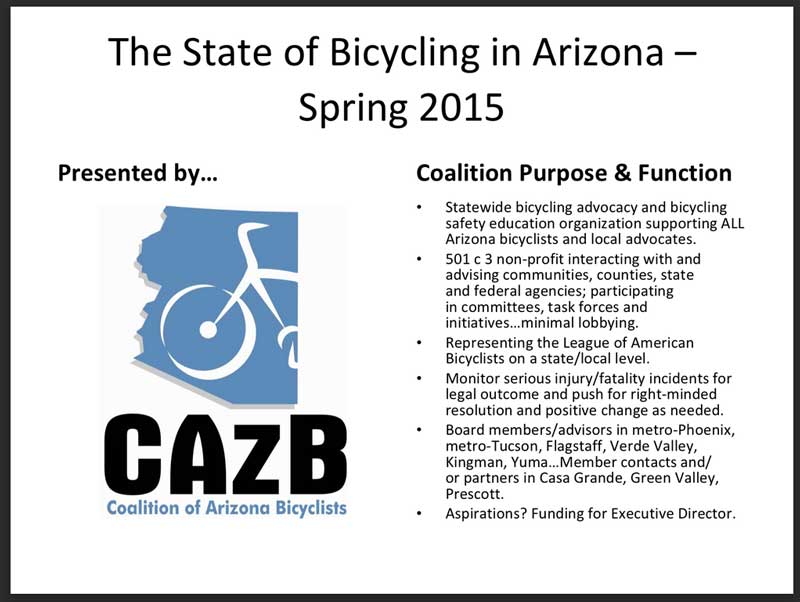Actually, we should have said: riders of bicycles are not bound by rules that apply only to drivers of motor vehicles…
It’s helpful to note that the “rules of the road” apply not to vehicles, or bikes, but rather to the people operating these things. A typical example is the rule for what to do at a stop sign, §28-855(B). “A driver of a vehicle approaching a stop sign shall stop…”.
In Arizona, bicycles are, by definition, not vehicles; nor are they motor vehicles. Here are those definitions §28-101:
§28-101. Definitions ... 58. "Vehicle" means a device in, on or by which a person or property is or may be transported or drawn on a public highway, excluding devices moved by human power or used exclusively on stationary rails or tracks. 33. "Motor vehicle": (a) Means either: (i) A self-propelled vehicle. (ii) For the purposes of the laws relating to the imposition of a tax on motor vehicle fuel, a vehicle that is operated on the highways of this state and that is propelled by the use of motor vehicle fuel. (b) Does not include a motorized wheelchair, an electric personal assistive mobility device or a motorized skateboard...
So, if a bicycle is not a vehicle, why does a cyclist have to stop at stop signs? Simple, because of a law helpfully titled Applicability of traffic laws to bicycle riders, §28-812,
§28-812. Applicability of traffic laws to bicycle riders A person riding a bicycle on a roadway or on a shoulder adjoining a roadway is granted all of the rights and is subject to all of the duties applicable to the driver of a vehicle by this chapter and chapters 4 and 5 of this title, except special rules in this article and except provisions of this chapter and chapter 4 and 5 of this title that by their nature can have no application.
This is a cyclist’s fundamental right to the road; the equal of driver’s.
Note well that it refers specifically to the rights and duties of the driver of vehicle — and NOT the driver of MOTOR vehicle, in fact the word motor does not appear at all in 28-812.
It might surprise you to note that the phrase “motor vehicle” occurs only a handful of places in ARS Title 28, Transportation, with respect to how a driver must operate a vehicle. By far, most driver’s duties refer, as in the stop sign example above, simply to vehicle.
Some references are incidental; lane and speed restrictions on motor vehicles weighing over 26,000 pounds (§28-736, §28-709). Another was intended to set minimum passing clearance when a motor vehicle overtakes a bicycle (§28-735). Two germane examples for cyclists are following distance, and impeding traffic.
§28-730, “The driver of a motor vehicle shall not follow another vehicle more closely than is reasonable and prudent…”, without the word motor in this statute, pacelining would likely be illegal. Since reasonable people would probably agree that a couple of inches is an inappropriately small following distance.
§28-704(A), “A person shall not drive a motor vehicle at such a slow speed as to impede or block the normal and reasonable movement of traffic…”. This is what I refer to as the cyclist’s second most fundamental right to the road, because if this statute were to apply to cyclists, then they would in effect be not allowed to use any road where traffic even might be impeded; regardless of number of lanes, width, presence or absence of a bike lane, or anything else. There is some detailed minutia [see footnote 2, here] revolving around what is meant by the “normal and reasonable movement” but that is immaterial to cyclists, since this section is inapplicable to them.
Likewise, §28-701(E) “A person shall not drive a MOTOR vehicle at a speed that is less than the speed that is reasonable and prudent under existing conditions”, never applies to bicyclists.
The point is that the phrase motor vehicle is used sparingly and deliberately to apply only to drivers of that type of vehicle, reflecting clear legislative intent. In the case of 28-704(A) to allow cyclists to use all roads even though motorists might sometimes be impeded (with some caveats: There is a specific allowance for prohibiting bicycles on controlled access highways, and other roads on a case-by-case basis). And the purpose of these laws is so that bicyclists can ride both legally and safely in the road according to best practices.
Arizona is one of 42 states (and the UVC) that makes it explicit that only motor vehicle drivers are subject to the impeding law; and in any event the impeding rule as interpreted must take into account the capability of the vehicle in determining if a violation has taken place; see Trotwood v. Selz, concerning an Ohio bicyclist, and Lott v. Smith, concerning a Georgia farmer driving a combine.
this is one of an occasional series on laws governing bicycle use in Arizona


